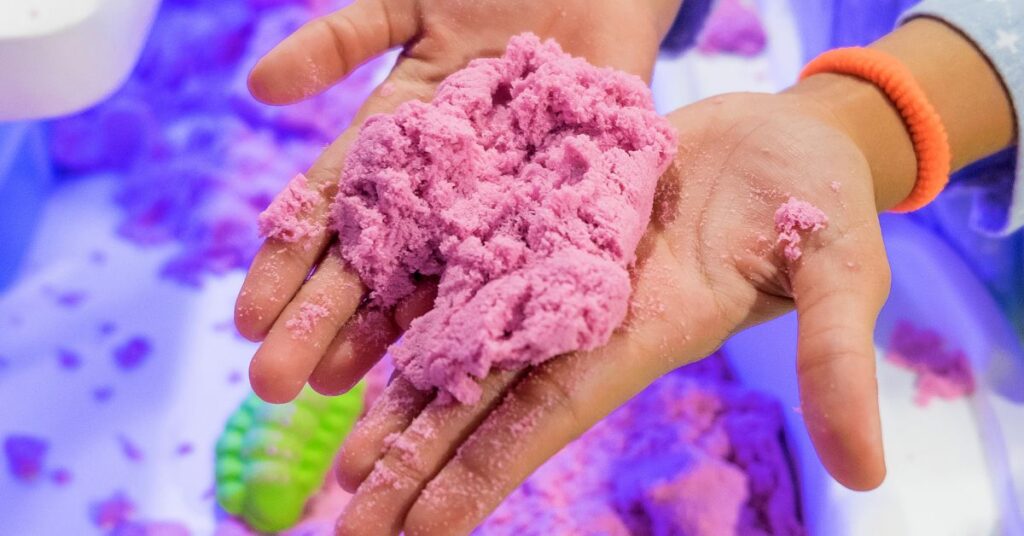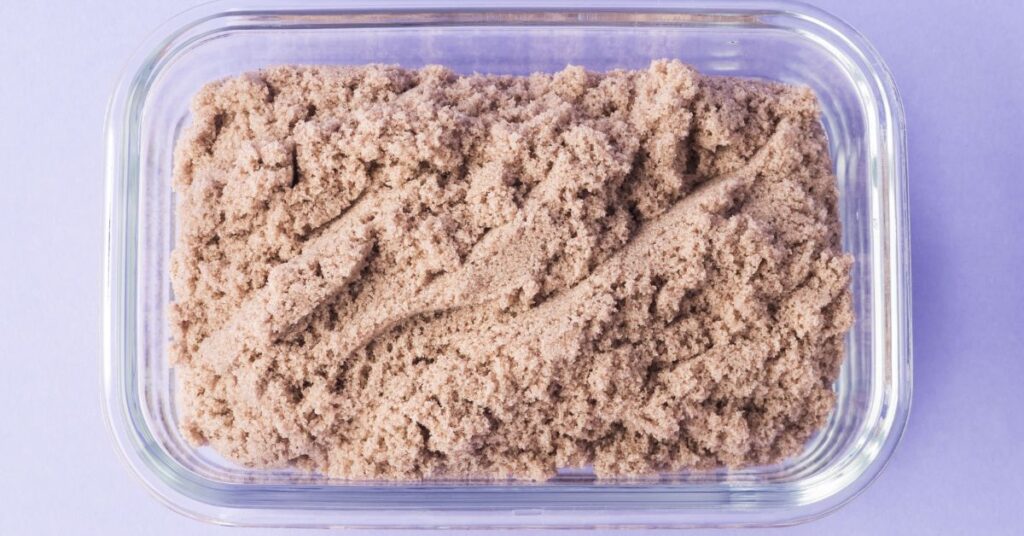Kinetic sand is one of the newer toys on the market, and it’s a lot of fun! But does kinetic sand dry out? And if it does, how can you prevent it?
Even though Spin Master assures that kinetic sand is partially made by magic, there are still a few factors you may consider to keep your kinetic sand in good shape.
Table of Contents
What Is Kinetic Sand?
Kinetic sand (see also ‘How Much Sand Do I Need For My Sandbox?‘) is a type of toy sand that has special properties. It is made of 98% regular sand. The other two percent of kinetic sand is made up of polymers (polydimethylsiloxane, or in simple words – silicon oil). These are long-chain molecules that have sticky and lubricating properties.
That’s what gives kinetic sand its unique feel and ability to hold shape. You can use kinetic sand for all sorts of purposes such as building, molding, and sculpting. It’s also great for relaxing and de-stressing.
Although there is chemistry involved in making kinetic sand, makers made sure, that their sand is non-toxic, hypoallergenic, and completely safe for kids aged three and up.
The sand is also gluten and paraben free. It doesn’t mean you should let your kids eat it. It is sand after all and can cause constipation and bowel problems if ingested in larger quantities.
Does Kinetic Sand Dry Out?

According to the manufacturer, kinetic sand doesn’t dry out, so it can be used over and over again. It is due to the “magical properties” of silicone oil (the polymer added to the regular sand). Silicone oil is often used in other industries, mostly as a lubricant.
Because of this oil coating, and no added water, kinetic sand retains its properties as a soft malleable, and squishy toy.
Silicon oil makes the kinetic sand look and act like wet sand but without the mess of the actual wet sand. It doesn’t dry out, but also doesn’t stick to your hands like regular wet sand. It is also viscoelastic – the viscosity increases the more you play with it. It means, that the more you work the kinetic sand in your hands, making it warmer, the gooier it becomes. A little bit like honey in texture.
It also means, that the less you mold the sand, letting it cool down, the less elastic it becomes. Similar to rubber. The oil is also hydrophobic, which translates to repelling water.
Those properties of silicon oil also make kinetic sand stick to itself but not other common surfaces, making it a clean toy to play with, even on a dinner table.
How To Keep Kinetic Sand Fresh?
The magic of kinetic sand is mighty and lasts a long time, but like every other toy needs a little TLC from time to time. If you want to keep your kinetic sand in tip-top condition, there are a few things you should keep in mind.
- First, be sure to store the sand in a sealed container or bag when it’s not in use. Kinetic sand never dries out, but it may be sensitive to moisture, and therefore lose its texture. Keeping it locked will protect it from additional moisture and other elements that could cause it to deteriorate.
- Second, don’t leave the sand out in the sun for extended periods. Although neither sand nor silicone oil don’t go bad under extended exposure to sunlight, the heat can cause the sand to become too soft and difficult to work with.
- Third, don’t leave the sand in the rain or submerged in water. Kinetic sand doesn’t usually absorb water thanks to the silicon oil water-repellent capabilities, but to be on the safe side, you should protect it from the elements. Too much moisture can also lead to sticky kinetic sand and make it difficult to use.
- Finally, let your kids play with the sand often to keep it in good shape.
By following these simple tips, you can ensure that your kinetic sand will keep its prime condition and stay magical forever.
How to Revive Kinetic Sand?

Kinetic sand is one of those materials that can be easily taken for granted. It’s so easy to use and manipulate that we often don’t think about how to take care of it properly.
However, kinetic sand is a somewhat delicate material, and if not cared for correctly, it can become crumbly, with bad texture, which would render it unusable.
If your kinetic sand starts to feel a little bit off – i.e., the texture gets too dry to work with or it doesn’t stick together properly – there’s no need to worry.
You can always revive your kinetic sand by adding a few drops of water to it and working it for a while in your hands. The water will help rehydrate the kinetic sand, making it soft and pliable again.
Final Words
Manufacturers swear that kinetic sand never dries out, but it is best if you still take proper care of it.
Now that you know how to do this, your kinetic sand will last for a long time. You can also revive it if it starts to feel off for whatever reason.
Just be sure to store it in a sealed container or bag when not in use and keep it out of the sun, rain, and water, and make sure your kids are playing with it constantly to keep it in good form.
With these simple tips, you and your kids can enjoy hours of fun with this fascinating material!






